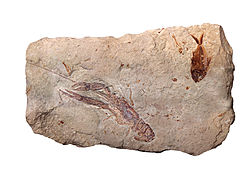Portal:Paleontology
 From Wikipedia the free encyclopedia
From Wikipedia the free encyclopedia
| The Palaeontology Portal Introduction Paleontology (/ˌpeɪliɒnˈtɒlədʒi, ˌpæli-, -ən-/ PAY-lee-on-TOL-ə-jee, PAL-ee-, -ən-), also spelled palaeontology or palæontology, is the scientific study of life that existed prior to, and sometimes including, the start of the Holocene epoch (roughly 11,700 years before present). It includes the study of fossils to classify organisms and study their interactions with each other and their environments (their paleoecology). Paleontological observations have been documented as far back as the 5th century BC. The science became established in the 18th century as a result of Georges Cuvier's work on comparative anatomy, and developed rapidly in the 19th century. The term has been used since 1822 formed from Greek παλαιός ('palaios', "old, ancient"), ὄν ('on', (gen. 'ontos'), "being, creature"), and λόγος ('logos', "speech, thought, study"). Paleontology lies on the border between biology and geology, but it differs from archaeology in that it excludes the study of anatomically modern humans. It now uses techniques drawn from a wide range of sciences, including biochemistry, mathematics, and engineering. Use of all these techniques has enabled paleontologists to discover much of the evolutionary history of life, almost all the way back to when Earth became capable of supporting life, nearly 4 billion years ago. As knowledge has increased, paleontology has developed specialised sub-divisions, some of which focus on different types of fossil organisms while others study ecology and environmental history, such as ancient climates. (Full article...) Selected article on the prehistoric world and its legacies Compsognathus (meaning 'elegant jaw') was a small, bipedal, carnivorous theropod dinosaur. The animal was the size of a chicken and lived around 150 million years ago, during the early Tithonian stage of the late Jurassic Period, in what is now Europe. Paleontologists have found two well-preserved fossils, one in Germany in the 1850s and the second in France more than a century later. Compsognathus is one of the few dinosaurs for which the diet is known with certainty: the remains of small, agile lizards are preserved in the bellies of both specimens. Teeth discovered in Portugal may be further fossil remains of the genus. Although not recognized as such at the time of its discovery, Compsognathus is the first dinosaur known from a reasonably complete skeleton. Today, C. longipes is the only recognized species, although the larger specimen discovered in France in the 1970s was once thought to belong to a separate species, C. corallestris. Until the 1980s and 1990s, Compsognathus was the smallest known dinosaur and the closest supposed relative of the early bird Archaeopteryx. Thus, the genus is one of the few dinosaur genera to be well known outside of paleontological circles. (see more...) Did you know?

General images -The following are images from various paleontology-related articles on Wikipedia. Selected article on paleontology in human science, culture and economics On the Origin of Species, published in 1859, is a work of scientific literature by Charles Darwin which is considered to be the foundation of evolutionary biology. Darwin's book introduced the scientific theory that populations evolve over the course of generations through a process of natural selection. It presented a body of evidence that the diversity of life arose by common descent through a branching pattern of evolution. Darwin included evidence that he had gathered on the Beagle expedition in the 1830s and his subsequent research findings. Ideas about the transmutation of species were controversial as they conflicted with beliefs that species were unchanging parts of a designed hierarchy and that humans were unique and unlike animals. The book was written for non-specialist readers and attracted widespread interest upon its publication. As Darwin was an eminent scientist, his findings were taken seriously and the evidence he presented generated scientific, philosophical, and religious discussion. Within two decades there was widespread scientific agreement that evolution, with a branching pattern of common descent, had occurred, but scientists were slow to give natural selection the significance that Darwin thought appropriate. During the "eclipse of Darwinism" from the 1880s to the 1930s, various other mechanisms of evolution were given more credit. With the development of the modern evolutionary synthesis in the 1930s and 1940s, Darwin's concept of evolutionary adaptation through natural selection became central to modern evolutionary theory, and it has now become the unifying concept of the life sciences. (see more...) On this day...April 23:
Imperfect Isolation: Factors and Filters Shaping Madagascar’s Extant Vertebrate Fauna Karen E. Samonds, Laurie R. Godfrey, Jason R. Ali, Steven M. Goodman, Miguel Vences, Michael R. Sutherland, Mitchell T. Irwin, David W. Krause published 23 Apr 2013 Selected image
CategoriesTopicsGeneral - Paleontology - Fossil - Evolution - Extinction Quality ContentFeatured paleontology articles - Achelousaurus - Acrocanthosaurus - Albertosaurus - Allosaurus - Amargasaurus - Ankylosaurus - Apatosaurus - Archaeopteryx - Baryonyx - Carnotaurus - Catopsbaatar - Ceratosaurus - Chicxulub Crater - Compsognathus - Cretaceous–Tertiary extinction event - Daspletosaurus - Deinocheirus - Deinonychus - Deinosuchus - Dilophosaurus - Dinosaur - Diplodocus - Dromaeosauroides - Edmontosaurus - Elasmosaurus - Giganotosaurus - Gorgosaurus - Herrerasaurus - Iguanodon - Istiodactylus - Lambeosaurus - List of dinosaur genera - Majungasaurus - Massospondylus - Megalodon - Nemegtomaia - Nigersaurus - Opisthocoelicaudia - Paranthodon - Parasaurolophus - Plateosaurus - Psittacosaurus - Seorsumuscardinus - Spinosaurus - Stegosaurus - Stegoceras - Styracosaurus - Tarbosaurus - Thescelosaurus - Triceratops - Tyrannosaurus - Velociraptor Things you can doCurrent Paleontology FACs - None yet... WikiProjectsRelated portalsAssociated WikimediaThe following Wikimedia Foundation sister projects provide more on this subject:
Discover Wikipedia using portals |








































